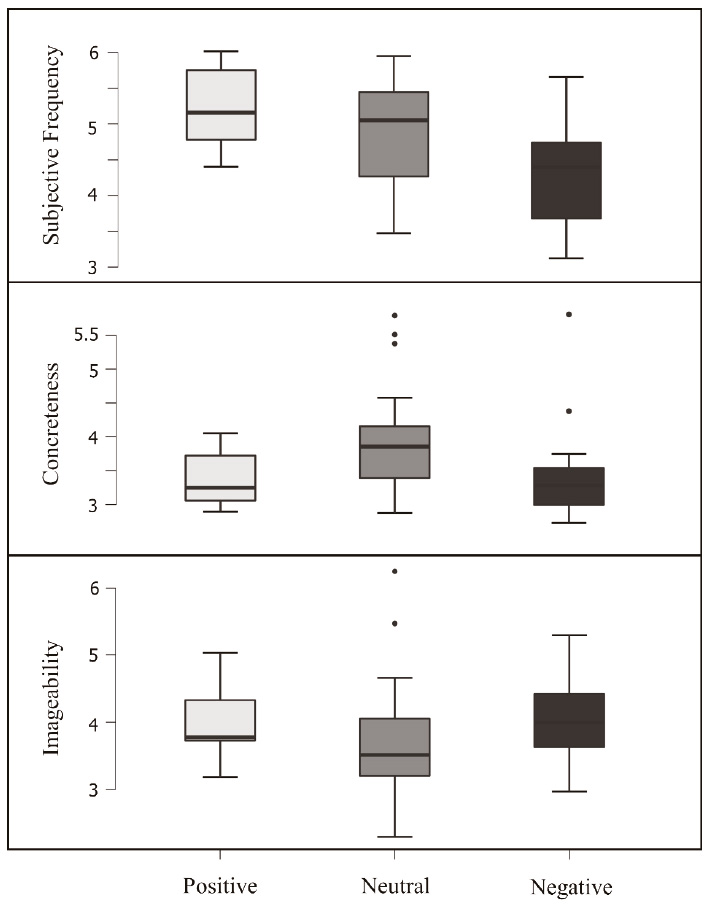Introduction
In everyday social interactions, humans rely on multiple sources of information to successfully communicate with one another. Visual, auditory, and contextual information provide fundamental cues to unveil the meaning, intentions and emotional state of others. Emotional prosody is crucial to emotional communication in speech, and it refers to the modulations of vocal acoustic parameters to convey emotions (Banse & Scherer, 1996). Different combinations of pitch (fundamental frequency), amplitude, speech rate and timbre index different emotional states. For example, a fast-paced utterance with ascending pitch contour and bright timbre may convey a joyful, positive-valence, emotional state; a slow, low-pitched utterance with an opaque timbre is associated with boredom or sadness (negative valence); and an utterance with a flat pitch contour, short duration and rapid speech rate may convey emotional neutrality (neutral valence).
Prosody is not the sole conveyer of emotional content, as emotions can also be communicated through the semantics of spoken words. In real world communication, the interplay between prosodic and lexical channels is ever-present, each channel alone having the capacity to modify the emotional meaning of an utterance (Kotz & Paulmann, 2007; Lin et al., 2020). The study of emotional prosody and its interplay with lexical content has received considerable attention in the past decades (see, for instance, Bąk, 2016; Paulmann, 2016), and neurocognitive models of vocal emotion comprehension have been proposed (Brück et al., 2011; Pell & Kotz, 2011; Schirmer & Kotz, 2006; Wright et al., 2018). These models converge on the idea that the input follows three major stages or subprocesses, ranging from (1) low-level acoustic analysis to (2) integrated emotional representations that become available to (3) cognitive judgement. Cognitive judgement represents the highest processing level, where the listener’s mind-brain uses both lexical and prosodic meaning to access the speaker’s emotions.
Prosodic and lexical information channels are processed by the mind-brain independently at the first stages of the processing chain (Schirmer & Kotz, 2006; see also Hickok & Poeppel, 2007). Therefore, lexico-prosodic integration is a major component of the highest-level subprocess - cognitive judgement. At this stage, listeners become able to perform two tasks: (i) judging lexico-prosodic congruence, and (ii) labeling emotions explicitly (see Brück et al., 2011; Schirmer & Kotz, 2006). The former task does not require participants to label the emotions portrayed in an attentive way, and thus may be addressed with implicit tasks. Tasks of lexico-prosodic congruence judgement typically use conflicting cues of information, such as the word “sad” spoken with a positive intonation (Bostanov & Kotchoubey, 2004; Mitchell et al., 2003; Schirmer & Kotz, 2003). Different experimental settings have been used, such as passive hearing (e.g., Paulmann & Kotz, 2008), Stroop tasks (e.g., Schirmer & Kotz, 2003) or other interference-based tasks, e.g., Lin et al., 2020; Paulmann & Pell, 2011). When studying lexico-prosodic integration in emotional prosody research, it is important to have language-specific stimulus sets addressing conflicting prosodic and lexical cues. Experimental manipulations of lexico-prosodic congruence can be achieved based on, at least, two theoretical approaches. One is a categorical approach, where basic emotion categories such as joy, sadness, anger, etc., are considered. In this case, incongruence arises from combining a lexical item that conveys a given emotion with a prosodic pattern that characterizes a different emotion, such as the word “joy” spoken with surprised prosody, or the word “sad” with angry prosody. The other approach is a dimensional one, focusing on bipolar dimensions that characterize emotional contents as positive/pleasant vs. negative/unpleasant (valence), or associated with high vs. low physiological activation (arousal). Here, incongruence occurs when the lexical item is combined with a prosodic pattern pertaining to the opposite side of the bipolar axis (e.g., a positive word with a negative prosody). A major advance in the debate on whether emotions are represented as categories or dimensions (e.g., Cowen et al., 2019; for a review, see Hamann, 2012) has recently been made by Giordano et al. (2021), who presented MEG and fMRI evidence for a conciliatory view: vocal emotional processing would first be represented in a categorical manner and then become progressively incorporated into a valence classification (negative, neutral or positive). Given that lexico-prosodic incongruence judgements are expected to occur at a later stage in the emotion recognition process (Schirmer & Kotz, 2006), it is reasonable to expect that the mind-brain will respond to incongruences based on the representations that are available at that stage - i.e., dimensional ones.
Another important remark must be made regarding the status of lexical and prosodic neutrality. At the lexical level, neutral words have properties that differentiate them from negative and positive ones: they are processed more slowly (Kousta et al., 2009) and tend to show specific psycholinguistic properties such as higher scores of concreteness and lower scores of imageability (e.g., Kousta et al., 2011; Soares et al., 2016). Thus, along with positivity and negativity, lexical neutrality seems to be well-represented in the mind-brain, with multiple studies acknowledging the relevance of this triadic contrast at the lexico-semantic level (e.g., Kousta et al., 2011; Pinheiro et al., 2016). At the prosodic level, the dyadic approach to valence (positive-negative) has been dominant in the literature, but empirical findings have shown that emotion-specific prosodic patterns are discriminated from neutral ones in the context of congruent lexico-prosodic combinations (e.g., Paulmann & Kotz, 2008). Such evidence raises the possibility of three distinct prosodic valence segments - positive, negative and neutral. Our approach intended to further explore the validity of this triadic approach.
Therefore, in the present study, we opted for a dimensional approach - specifically, a triadic (negative, neutral, positive), valence-based approach to emotional prosody.
Rationale behind stimulus creation and validation
Validated emotional prosody stimulus materials available for research in European Portuguese (EP) are not suitable to address lexico-prosodic integration. To our knowledge, available materials are limited to a set of emotion-specific prosodic patterns in sentences and pseudo-sentences (Lima & Castro, 2010), and a set of valence-specific (liking vs. disliking) prosodic patterns used on neutral words (Filipe et al., 2015). These materials are suitable for studying the explicit labelling of emotions (e.g., Castro & Lima, 2014; Correia et al., 2019), but, given the absence of conflicting prosodic vs. lexical cues in these stimuli, lexico-prosodic integration is left out. Due to lack of materials to study emotional lexico-prosodic integration in European Portuguese, we aimed to bridge that gap in the present work. To that end, we generated and validated an auditory set of emotional words spoken with congruent vs. incongruent prosodic pattern (e.g., the word alegre was read both with a congruent/happy and an incongruent/sad prosodic pattern).
To manipulate lexico-prosodic congruence based on valence, we used three lexical-valence levels: positive, negative, and neutral words. For each of these classes, we created prosodic matches (congruence) and prosodic mismatches (incongruence): prosodic matches for positive, negative, and neutral words corresponded to positive, negative and neutral prosodic patterns, respectively; prosodic mismatches for positive and negative words were negative and positive prosodic patterns, respectively; prosodic mismatches for neutral words included two types - positive and negative prosodic patterns (Figure 1). When defining the neutral match as a neutral word with neutral prosody, we assumed that - paralleling lexical neutrality - prosodic neutrality is psychologically real and may be seen as the central segment of a valence continuum.
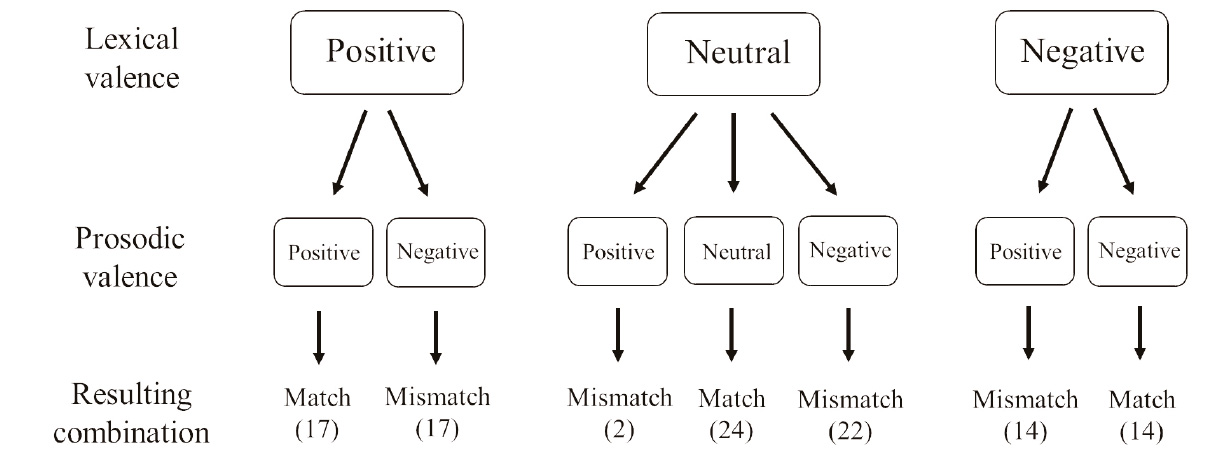
Figure 1 Schematic representation of the validated stimuli. A total of 110 audio files (55 pairs) reflected optimal lexico-prosodic contrast
The creation and validation of the stimuli went through the following stages. First, we sought for a published lexical stimulus set specifically organized into positive, negative and neutral valence categories where valence categories had shown experimental effects (Pinheiro et al., 2016), from which we extracted 90 words. We checked the emotional valence of the lexical items in the Portuguese databases ANEW (Soares et al., 2011) and EMOTAIX PT (Costa, 2012), which originated the exclusion of some items. The remaining subset was read aloud by a trained speaker with congruent and incongruent prosodies. The utterances were then submitted to ratings of lexico-prosodic congruence by a group of participants, and a second selection was made.
The prosodic patterns of the resulting selection were validated acoustically for the intended positive, negative, and neutral emotional prosodies. Following classic findings on the acoustic features that seem to be most relevant to differentiate emotions (Banse & Scherer, 1996; Goudbeek & Scherer, 2010; Juslin & Laukka, 2003; Lima & Castro, 2010; Pell & Skorup, 2008), we focused on duration (in ms), mean fundamental frequency (F0, measured in Hz, representing the vibration frequency of the vocal folds), F0 variation (measured as the standard deviation of F0), amplitude variation (standard deviation) and amplitude range. In addition to basic acoustic descriptors, we compared valence levels according to timbral parameters. Timbral parameters refer to spectral dimensions associated with tone color (e.g., Dowling & Harwood, 1986) or perceptual quality of sounds (Handel, 1995). The acoustic substrate of timbre comprises the relation between the partials of a complex sound, the distribution of energy across the spectrum, as well as the spectral envelope. Timbral measures have not been considered as standard acoustic descriptors of emotionality in the literature (see, e.g., Juslin & Laukka, 2003; Lima & Castro, 2010; Pell & Skorup, 2008; Preti et al., 2015). Recently, Tursunov and colleagues (2019) proposed a set of timbral acoustic descriptors which more accurately distinguished the valence of emotions. These descriptors include: spectral centroid, representing the spectral center of gravity; spectral spread, representing the spread around the mean value; spectral crest, or the crest factor of the spectrum, translating the ratio of peak-average power; inharmonicity, a measure of how partial portions of the signal differ from purely harmonic frequencies; noisiness, the degree to which the signal is harmonic or not; tristimulus, a measure conceived to define the first harmonics within the spectrum, based on three energy ratios.
Once acoustic validation was finished, lexical items were catalogued for their psycholinguistic properties according to previously validated norms.
The outcome was a validated set of 110 words (55 congruent and 55 incongruent) that can be used for emotion and language research in European Portuguese. These steps are detailed below.
Methods
Selection of lexical items
As Pinheiro et al.’s (2016) lexical database contained positive, negative and neutral valence words - the same triadic view we intended to follow -, we used it to select 90 words, 30 of each valence level, that we then translated from English (the original language of the dataset) into Portuguese. Contrary to English, Portuguese has grammatical gender inflections (masculine, feminine and invariable wordforms). While about 40% of the translated words remained gender-invariable (e.g., “excellent” corresponds to excelente, invariable in Portuguese), the remaining did not; for example, “satisfied” corresponds to the gender-marked wordforms satisfeita (feminine) and satisfeito (masculine) in Portuguese. In these cases, to balance grammatical gender in our stimuli, half was translated into the masculine form (e.g., “fantastic” was translated to fantástico) and the other half to the feminine form (e.g., “furious” was translated to furiosa).
To ensure that the translated words had the same valence as the original ones, we confirmed their valence in the two largest emotional-word databases that have been validated for European Portuguese: ANEW (Soares et al., 2011; original version, Bradley & Lang, 1999) and EMOTAIX PT (Costa, 2012; original version, Piolat & Bannour, 2009). ANEW presents mean valence scores and standard deviations for 1034 emotional words. Scores range from 1 to 9, with 5 representing a valence cutoff under which words would be unpleasant (negative valence), and above which they would be pleasant (positive valence). In EMOTAIX PT, 3983 words are classified according to three hierarchical valence category systems (basic, supra and super categories). Supra categories are the most relevant to us, since they correspond to positive valence (including benevolence, well-being, and composure) vs. negative valence (malevolence, ill-being, and anxiety). Super (n=8) and basic categories (n=50) are further subdivisions of supra categories, with more specificity (for instance, the word horror belongs to the super category of anxiety, the supra category of fear, and the basic category of dread). In addition, EMOTAIX includes non-hierarchical categories standing outside the valence poles established by supra categories. These valence-unrelated categories include surprise, unspecified emotions, and impassiveness.
The inclusion of words in our set was based on the following criteria: Positive and negative words were kept if they were present in at least one of the two databases with the expected valence. Specifically, they should be part of EMOTAIX (as positive/negative words when positive/negative valence was intended) or display mean valence scores in ANEW lower or higher than central values (mean±SD, 5±1.5) for negative and positive words, respectively. Given that EMOTAIX and ANEW do not include a neutral label nor a numerical definition of neutral valence, we kept as neutral words those which were absent from both datasets, or which were included in EMOTAIX as unspecified emotion and absent from ANEW, or present in ANEW with a valence score within ±1 SD of the mean and absent from EMOTAIX. For example, the word casual (“casual”) was absent from EMOTAIX and present in ANEW with a valence score of 5.18, which is within the range of the mean ±1 SD), and therefore was taken as a neutral word. This would ensure that the words selected as neutral would fall around a central zone of a dimensional valence continuum. Finally, if a translated word was not present in the Portuguese databases, but a word with the same root morpheme was, we kept it in our dataset; for example, we kept the adjective horroroso because the noun horror was included in ANEW. After the exclusion of 6 translated words (3 positive, and 3 negative), the resulting set containing 84 words was recorded by the first author (RG) (for details, see the dedicated spreadsheet in the supplementary material).
Recording
Audio files were recorded by a 24-year-old male speaker (RG), with instructions being provided by the remaining authors. The selected set of lexical items was recorded twice: first with valence-congruent prosody (n=84, 27 positive words with positive prosody, 27 negative words with negative prosody and 30 neutral words with neutral prosody), and then with valence-incongruent prosody (n=114, 27 positive words with negative and with positive prosody, 30 neutral words with negative and with positive prosody). For congruent stimuli, the speaker embodied an emotional state that would justify the use of that word to characterize a person/object/situation, not portraying irony or sarcasm, e.g., the word triste (“sad”) with a sad prosody, or the word alegre (“happy”) with a happy prosody; for the incongruent ones, he used negative prosody for positive words, positive prosody for negative words, and both positive and negative prosody for neutral words. No rigid suggestions on the specific prosodic pattern to be used were given to the reader. Therefore, there was some variability in this domain. For example, the reader has employed both joyful, surprised or excited as positive prosodic patterns, and sad, disgusted, or enraged as negative prosodic patterns according to his discretion. Recordings were made in a sound-insulated booth at a sampling rate of 48-KHz and 16-bit resolution, using a high-quality cardioid microphone, an audio interface and version 2.3.3 of Audacity ® software (http://www.audacityteam.org/).
Files were RMS-normalized to +70 dB, and silences removed using Praat (http://www.fon.hum.uva.nl/praat). The 198 stimuli were then presented to listeners to evaluate whether the meaning suited the prosodic pattern.
Behavioral validation of lexico-prosodic incongruence
Sixty-eight healthy adults (51 women, mean age=22.81 years, SD=5.63) listened to the recorded set of words and were asked to rate their lexico-prosodic congruence using a 5-point Likert-type scale, ranging from 1 (Totally inadequate to meaning) to 5 (Totally adequate to meaning). Data collection was made in an acoustically shielded room using Presentation ® 21.1 (Neurobehavioral Systems, http://www.neurobs.com/). Participants listened to stimuli with high-quality loudspeakers, and responses were recorded using a 5-button response box. All participants engaged in five training trials before the experiment. Each trial was composed of a fixation cross (200 ms), the audio file, and then a question displayed on the computer screen (“Does the intonation match the meaning?”). The order of trials was pseudorandomized, assuring that consecutive occurrence of stimuli of the same experimental type (match & mismatch) did not exceed three, and two versions (A and B) were created by switching the order of the first and second halves. Half the participants listened to version A, and the other half to version B.
Acoustic validation of prosodic valence
To validate the valence-related prosodic labels of our stimuli (positive, negative and neutral patterns), we started by grouping the 110 items (55 pairs) according to prosodic valence, disregarding congruence. This resulted in 33 positive (17 lexically congruent and 16 lexically incongruent), 24 neutral (all of them lexically congruent), and 53 negative (14 congruent and 39 incongruent) utterances (Figure 1). We then extracted basic acoustic features for each utterance using Praat (http://www.fon.hum.uva.nl/praat/) and computed average values per prosodic class. Concerning timbral measures, the computation of minimum, maximum and median values for spectral centroid, spectral spread, spectral crest, inharmonicity, noisiness, and tristimulus was made with the Timbre Toolbox (Peeters et al., 2011) for MATLAB (www.mathworks.com).
Psycholinguistic properties
Finally, we characterized the psycholinguistic properties of the validated lexical items (n=55) using Minho Word Pool (Soares et al., 2016). This database includes three subjective measures for 3800 words in European Portuguese: imageability, capturing how easy it is for a word to evoke mental images, concreteness, measuring the extent to which a word reflects experienced situations, places or objects, and subjective frequency, representing a self-estimate of the relative frequency of word usage by an individual. Together with objective measures such as objective frequency (a measure of the actual frequency of word occurrence based on large lexical corpora) and word length, these are important measures to consider in psycholinguistic experiments, given that they might explain on its own a considerable portion of variance (Soares et al., 2016).
The search criteria in Minho Word Pool database were similar to what was described in the methods section, that is, whenever the same exact word was not found, we looked for the opposite grammatical gender, or words with the same root morpheme.
Statistical analysis and results
Behavioral validation
For each item, participant-averaged ratings were computed for congruent stimulus (e.g., one positive word with positive prosody) and its incongruent counterpart (the same word with negative prosody) for lexically positive, negative and neutral words. Differences greater than 2 points (e.g., 5 vs. 2.9, 4 vs. 1.9, 3 vs. 0.9) likely indicated relevant changes in the congruency of each word, and so we used this difference as a cutoff to distinguish between high-contrasting and low-contrasting pairs. As lexically neutral words had two incongruent counterparts (spoken with positive and negative prosody), we chose the one with the largest congruent-incongruent difference score. Using the cutoffs above, we arrived at 55 high-contrasting pairs (17 based on positive words, 24 based on neutral and 14 on negative, see Figure 1, Table 1 and supplementary materials) and 59 low-contrasting pairs (10 based on positive words, 36 on neutral and 13 on negative).
Table 1 List of validated words
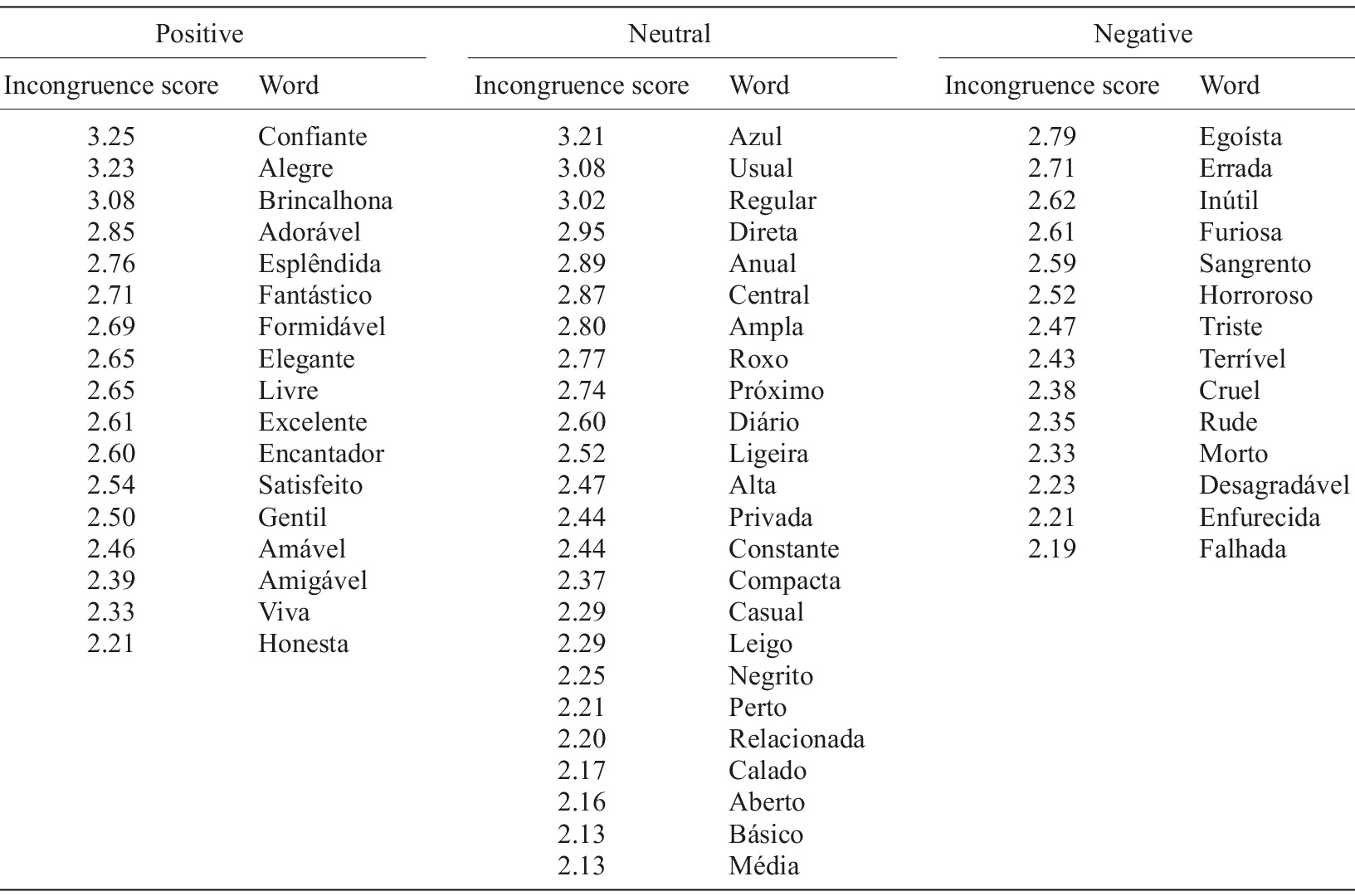
Note. Incongruence score - the difference between congruent and incongruent averaged ratings per item. Higher values represent stronger lexico-prosodic incongruence. For the English words, please consult the supplementary materials.
To check the cross-subject consistency in rates for high-contrasting pairs, paired samples t-tests comparing congruent and incongruent versions were run on the ratings for high- and low-contrasting pairs. For high-contrasting pairs, ratings for lexically congruent prosody items (M=4.34, SD=0.39) were significantly different from lexically incongruent prosody items [M=1.80, SD=0.41, t(67)=36.48, p<.001, Cohen’s d=4.42]. For low-contrasting pairs, results were similar: lexically congruent prosody items (M=3.76, SD=.48) differed significantly from lexically incongruent ones [M=2.60, SD=.48, t(67)=19.51, p<.001, Cohen’s d=2.37], but the effect size was smaller. These results lend support to the initial selection based on average ratings.
Acoustic validation
For basic acoustic measures (Table 2), we ran independent samples t-tests to investigate whether positive, negative and neutral utterances were differentiated, with Bonferroni corrections made to handle multiple comparisons (Table 3). Compared to neutral, positive utterances had significantly longer duration, higher fundamental frequency (F0), greater F0 variation and lower amplitude variation, with amplitude range not showing statistical differences. When compared to negative utterances, positive ones had significantly higher F0 and F0 variation, but duration, amplitude variation and range were similar. Finally, compared to negative, neutral utterances had significantly shorter duration and larger amplitude variation and range, but similar F0 and F0 variation. A summary of the analysis is presented in Table 4. In the present data, amplitude variation and range differed in negative-positive, and positive-neutral valence contrasts. However, no differences emerged in the negative-neutral contrast.
Table 2 Basic acoustic features for the validated set of words, grouped by emotional prosody

Note. n=110 (33 positive, 24 neutral, 53 negative prosodies). F0 - Fundamental Frequency; Amp SD - Amplitude variation, or the standard deviation of the Amplitude; Amp R - Amplitude range (Amp R=AmpMax - AmpMin).
Table 3 Independent samples t-tests for the basic acoustic parameters between positive, neutral and negative utterances
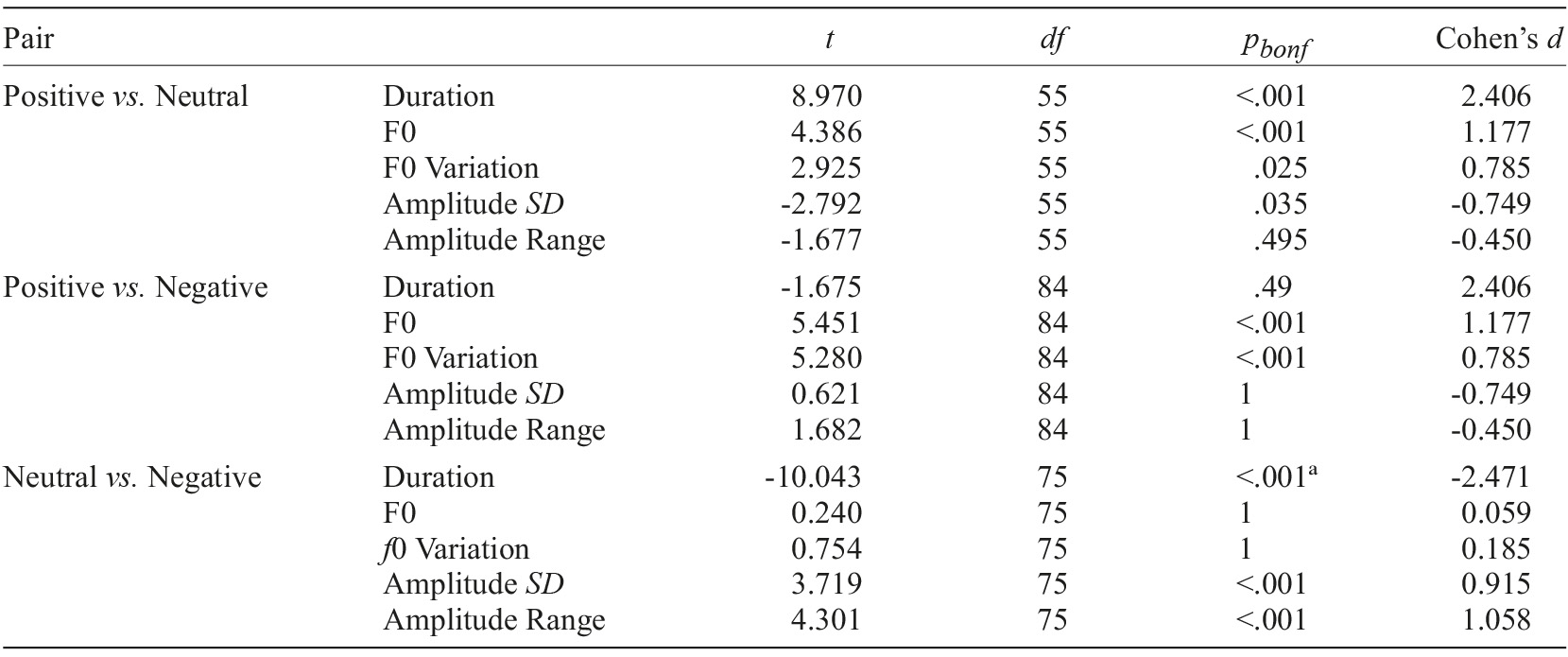
Note. p values are Bonferroni-corrected. a Levene’s test is significant (p<.05) suggesting a violation of the equal variance assumption.
Table 4 Acoustic features that showed statistically significant differences in the valence domain

Note. Asterisks stand for marginally significant results (p<.10).
Concerning timbral measures, we calculated independent samples t-tests with Bonferroni corrections for all the statistical measures to compare positive and neutral, positive and negative, as well as neutral and negative utterances (Table 5). Spectral centroid, spectral spread and tristimulus were effective in discriminating between positive and neutral words. Differences between positive and negative words were captured by spectral crest, although with marginal results. Finally, neutral utterances differed from negative ones only in tristimulus values. A table with the extracted timbral measures can be found in supplementary materials (2.4. Acoustic Measures).
Table 5 Timbre-based comparison between pairs of prosodic valence
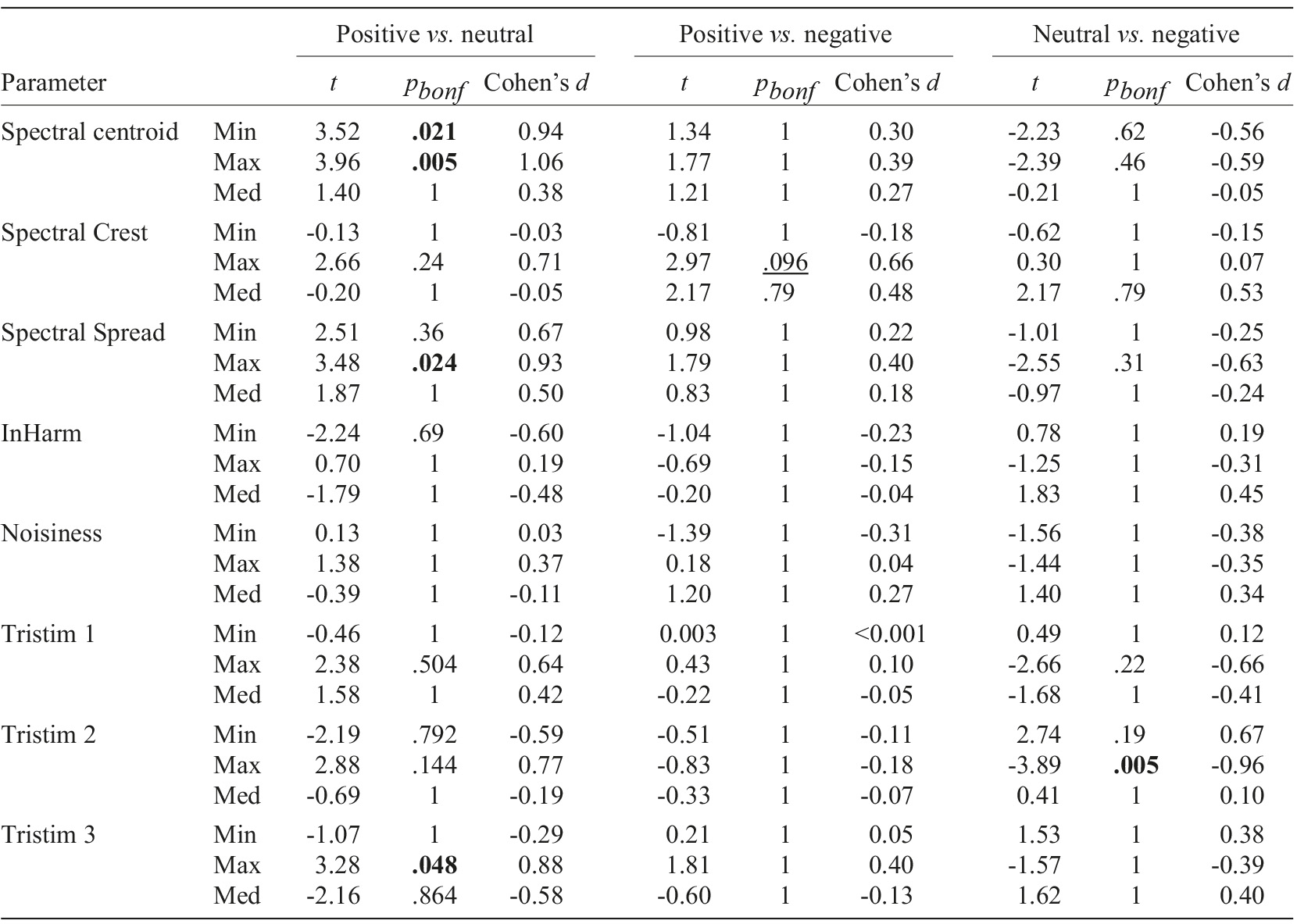
Note. Displayed p values are Bonferroni-corrected. Parameters in bold represent statistically significant results (p<.05); Underlined parameters refer to marginally significant results (p<.10). InHarm - Inharmonicity; Tristim - Tristimulus.
In sum, both basic acoustic measures and timbral descriptors provided evidence in favor of prosodic contrasts between positive and neutral, positive and negative, and negative and neutral valence pairs (see Table 4 for a summary of the relevant acoustic features for each pair). Therefore, the intended emotional prosody of the present set of utterances was validated.
Psycholinguistic properties of validated lexical items
Table 6 displays a summary of psycholinguistic properties for the validated set of words according to semantic valence (see supplementary material’s file 4. Psycholinguistic Properties for detailed data).
Table 6 Psycholinguistic properties according to Minho Word Pool

Note. 6 missings. Objective Freq - Objective frequency; Subjective Freq - Subjective frequency; WL_l - Word length (no. letters); WL_syll - Word length (no. syllables).
The main purpose of this level of description was cataloguing our stimulus set.
For exploratory purposes, we ran independent samples t-tests comparing positive vs. neutral, positive vs. negative, and neutral vs. negative words (Figure 2).
Positive and negative words did not differ significantly in any measure (ps>.28) except in subjective frequency [t(27)=3.93, p<.001, Cohen’s d=1.46]: positive words were subjectively more frequent than negative ones (Table 6). This may reveal a bias towards attributing positive color to our lexicon (Hepach, 2011), even though, in fact, the objective frequency does not differ. Compared to neutral words, positive words had significantly higher objective frequency (p=.015), concreteness (p=.024), and word length (p=.002 for number of letters, p=.007 for number of syllables), and marginally significant higher subjective frequency (p=.098), but no differences in imageability (p=.54). Finally, negative words had lower subjective frequency (p=.039), lower objective frequency (p=.007), and marginally significant higher world length (number of letters, p=.079) than neutral words, but no differences in concreteness (p=.102), imageability (p=.362), and word length (syllables, p=.15).
In sum, apart from subjective frequency, where positive words scored higher than neutral, and neutral higher than negative (Figure 2), we saw no obvious pattern of psycholinguistic contrast across the three valence levels. Unlike Altarriba and Bauer (2004) and Soares et al. (2016), we found no differences in concreteness and imageability between positive and negative words.
Discussion and conclusion
To make up for the absence of materials to study emotional lexico-prosodic integration in European Portuguese, we validated a set of utterances comprising positive, negative and neutral words spoken with congruent or incongruent emotional prosody organized into three valence levels, positive, negative and neutral. The validation procedure included lexical selection, behavioral validation of congruence, acoustic validation of differences across prosodic patterns, as well as psycholinguistic classification of words. The validated set elicited consistent and large differences in behavioral ratings for congruent vs. incongruent versions. Prosodic patterns for positive, negative and neutral utterances differed in several acoustic parameters, and the characteristics of these patterns were partly consistent with previous research findings (see below).
Notes on acoustic validation results
Though all three prosody-related emotional contrasts (positive-neutral, positive-negative, negative-neutral) showed significant differences in, at least, two out of five basic acoustic parameters (Table 4), parameters were not equally relevant across contrasts. For instance, duration was irrelevant to the positive vs. negative contrast, but relevant to the other two. This is in line with the literature (Banse & Scherer, 1996; Goudbeek & Scherer, 2010; Lausen & Hammerschmidt, 2020; Montenegro & Maravillas, 2015).
On the other hand, our data suggest that F0 parameters are not relevant for contrasting negative and neutral prosodic patterns, which contrasts with Preti et al. (2015). However, it should be noted, that, unlike us, Preti and colleagues (2015) operationalized negative valence as anger only, which can be a source of error on its own.
Among the timbral measures suggested by Tursunov et al. (2019), spectral descriptors seemed particularly relevant. In addition, timbral descriptors were clearly more helpful to distinguish positive from neutral utterances than the other pairs (positive-negative and negative-neutral). The irrelevance of timbral measures to the positive-negative comparison contrasts with the results from of Tursunov and colleagues (2019). One explanation may be that may be that Tursunov and colleagues (2019) included neutral emotions in the negative valence group. It is, thus, possible that the positive-negative contrasts in timbre that they saw reflected, at least partly, the positive-neutral differences we observed in our data. This strengthens the idea that, instead of grouping neutral with negative prosody, it may be useful to view neutral prosody as a valence level of its own.
Limitations and implications for future research
In this study, we adopted triadic views on lexical valence and prosodic valence, meaning that in both cases positive, negative and neutral qualities were considered. While this triadic view of lexical valence seems relatively consensual (e.g., Kousta et al., 2011; Pinheiro et al., 2016), the same does not hold for prosodic valence, where the concept of neutral prosody tends to not be integrated into valence analyses. Although this lack of comparability with extant research may be viewed as limitation of the present study, our triadic view on prosody gained some support from our data. Our results suggest that neutral prosody might indeed have a separate representation in the brain: behavioral results demonstrated that neutral words with neutral prosody show higher congruence scores than neutral words with negative prosody and, though less marked, with positive prosody. This finding leads us to propose that future valence-oriented prosody research would benefit from considering the neutral level. Furthermore, it suggests that studies using neutral lexical content combined with emotional prosody as a way to minimize lexical interference (e.g., Lima & Castro, 2010; Paulmann & Kotz, 2008) may not be entirely free from confounds, as the combination of lexical neutrality with emotional prosody might be a source of incongruence.
Besides behavioral validation, the idea of neutral prosodic valence was supported by our acoustic analysis of prosodic patterns: neutral utterances showed significant differences compared to positive and negative ones, not only in durational, F0, and amplitude-related values (traditional descriptors), but also in timbral measures. The observed differences in traditional descriptors - which were also present in the comparison between positive and negative prosody - stress the relevance of these measures for signaling emotion (e.g., Goudbeek & Scherer, 2010; Juslin & Laukka, 2003; Lima & Castro, 2010). Such descriptors seem useful to distinguish not only between emotion categories (sadness, joy, etc.), but also to distinguish between valence classes (positive, negative, neutral).
A central contribution of our study for the neurocognition of emotion research field lies in the fact that our validated stimulus set offers a tool to address the cognition-related level of emotional processing in European Portuguese: emotional lexico-prosodic integration, assessed via lexico-prosodic incongruence detection. Besides the numerous applications that come with the possibility of addressing this substage of emotional prosody processing, our materials provide new opportunities to investigate the relations between the two substages of high-level cognitive processing in this domain: lexico-prosodic integration and explicit emotion recognition. Furthermore, it can be used to address later, highly cognitive emotional prosody subprocesses with no need to engage explicit emotion labelling (emotion recognition tasks, as in Lima & Castro, 2010). Given that lexico-prosodic incongruence triggers an implicit response (e.g., Paulmann & Kotz, 2008), this set is also appropriate for implicit tasks, which widens the experimental scope of possibilities in emotional prosody research. Also, given that the present set is composed of words and not sentences, it may be more suitable to ERP studies in that it allows for finer time-course parametrizations such as precise trigger positioning.
Our validated set also contributes to developments in clinical applications: as emotional prosody can be used to address the deterioration of neurocognitive systems (e.g., Lima et al., 2013; see also Bak, 2016), this set may serve as a tool to assess the integrity of vocal emotional processing in novel ways, namely without requiring patients to consciously recognize the emotions being conveyed. It may, furthermore, be used to address selective impairments of integration vs. emotional recognition, where one, but not the other, cognitive mechanism might be affected.
In sum, the present set of stimuli is relevant for various fields of research where emotion, language and its relations play a role.














